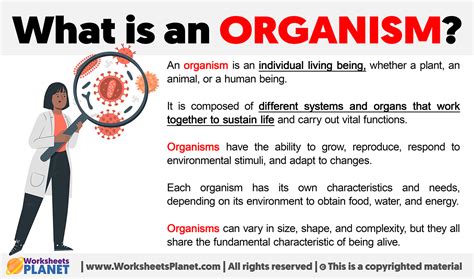What An Organism

An organism is a complex structure consisting of cells, which are the basic units of life. All living things, from bacteria to humans, are composed of one or more cells, and these cells work together to maintain the overall health and function of the organism. The concept of an organism is fundamental to biology, as it represents the most basic level of life that can maintain its own vital functions, reproduce, and respond to environmental stimuli.
Organisms can be classified into different categories based on their characteristics, such as their cell structure, metabolism, and mode of reproduction. For example, prokaryotic organisms, such as bacteria, lack a true nucleus and other membrane-bound organelles, whereas eukaryotic organisms, such as plants and animals, have a true nucleus and other complex cellular structures. Additionally, organisms can be classified as autotrophic, meaning they produce their own food through photosynthesis or other means, or heterotrophic, meaning they obtain their food by consuming other organisms or organic matter.
Key Points
- An organism is a complex structure consisting of cells, which are the basic units of life.
- Organisms can be classified into different categories based on their characteristics, such as cell structure, metabolism, and mode of reproduction.
- Prokaryotic organisms, such as bacteria, lack a true nucleus and other membrane-bound organelles.
- Eukaryotic organisms, such as plants and animals, have a true nucleus and other complex cellular structures.
- Organisms can be classified as autotrophic or heterotrophic based on their mode of nutrition.
Characteristics of Organisms

Organisms exhibit a range of characteristics that distinguish them from non-living things. These characteristics include the ability to maintain homeostasis, or a stable internal environment, despite changes in the external environment. Organisms also exhibit the ability to grow and develop, which involves an increase in size and complexity over time. Additionally, organisms are capable of reproducing, either sexually or asexually, in order to produce new individuals and ensure the continuation of their species.
Another key characteristic of organisms is their ability to respond to environmental stimuli. This can include responses to changes in light, temperature, touch, and other environmental factors. Organisms also exhibit the ability to metabolize, or break down and synthesize, organic molecules in order to maintain their vital functions and produce energy. Finally, organisms are capable of evolving over time through the process of natural selection, which allows them to adapt to changing environmental conditions and increase their fitness.
Types of Organisms
There are many different types of organisms, ranging from simple bacteria to complex plants and animals. Each type of organism has its own unique characteristics and adaptations that allow it to thrive in its environment. For example, bacteria are able to survive in a wide range of environments, from the freezing cold to the extremely hot, and are capable of breaking down and synthesizing a wide range of organic molecules. Plants, on the other hand, are able to produce their own food through photosynthesis and are often the primary producers in ecosystems.
Animals, including humans, are heterotrophic organisms that obtain their food by consuming other organisms or organic matter. They are capable of moving and responding to environmental stimuli, and exhibit a range of complex behaviors and social structures. Fungi, such as mushrooms and molds, are also heterotrophic organisms that obtain their food by breaking down and synthesizing organic molecules. They play a critical role in ecosystems, helping to decompose organic matter and recycle nutrients.
| Category | Characteristics |
|---|---|
| Prokaryotic | Lack true nucleus, lack membrane-bound organelles |
| Eukaryotic | True nucleus, membrane-bound organelles |
| Autotrophic | Produce own food through photosynthesis or other means |
| Heterotrophic | Obtain food by consuming other organisms or organic matter |

Importance of Organisms

Organisms play a critical role in maintaining the health and function of ecosystems. They are the primary producers, consumers, and decomposers, and help to cycle nutrients and energy through the environment. Without organisms, ecosystems would not be able to function, and the planet would be a very different place. Additionally, organisms have many practical applications in fields such as medicine, agriculture, and biotechnology, and are a key component of many industries and economies.
Organisms also have a significant impact on human health and well-being. Many organisms, such as bacteria and viruses, can cause disease and illness, while others, such as plants and fungi, have been used for centuries to develop medicines and treatments. Additionally, organisms are a key component of many traditional medicines and healing practices, and continue to be an important area of research and development in the field of medicine.
Conservation of Organisms
Unfortunately, many organisms are facing significant threats to their survival, including habitat destruction, climate change, and pollution. As a result, conservation efforts are necessary to protect and preserve the diversity of life on Earth. This can include efforts such as habitat preservation, species reintroduction, and the development of sustainable practices and technologies. By working to conserve and protect organisms, we can help to maintain the health and function of ecosystems, and ensure the long-term survival of our planet.
It is also important to recognize the importance of organisms in maintaining ecosystem services, such as pollination, pest control, and nutrient cycling. These services are essential for maintaining the health and productivity of ecosystems, and are often provided by a diverse range of organisms, including insects, plants, and microorganisms. By conserving and protecting these organisms, we can help to maintain the health and function of ecosystems, and ensure the long-term survival of our planet.
What is the difference between a prokaryotic and eukaryotic organism?
+Prokaryotic organisms, such as bacteria, lack a true nucleus and other membrane-bound organelles, whereas eukaryotic organisms, such as plants and animals, have a true nucleus and other complex cellular structures.
What is the importance of organisms in ecosystems?
+Organisms play a critical role in maintaining the health and function of ecosystems, and are the primary producers, consumers, and decomposers. They help to cycle nutrients and energy through the environment, and are essential for maintaining the health and productivity of ecosystems.
Why is conservation of organisms important?
+Conservation of organisms is important because many organisms are facing significant threats to their survival, including habitat destruction, climate change, and pollution. By conserving and protecting organisms, we can help to maintain the health and function of ecosystems, and ensure the long-term survival of our planet.


